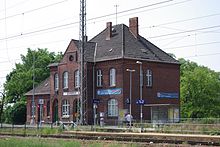Study society for electric rapid transit systems
The Study Society for Electric Rapid Railways (St.ES) was founded on October 10, 1899 in Berlin with the aim of gaining practical experience with high speeds in electric traction .
The experiments were also intended to clarify whether an overhead line would be suitable for supplying power even at high speeds instead of a conductor rail , as was often used in the first electric railways.
Shareholder
The shareholders were the leading electrical companies Allgemeine Elektricitäts-Gesellschaft and Siemens & Halske , the banks Delbrück Leo & Co , Deutsche Bank , Nationalbank für Deutschland and Jacob SH Stern as well as the mechanical engineering companies of August Borsig , Philipp Holzmann & Co. , Friedrich Krupp and Van der Zypen & Charlier . Deutsche Bank led the consortium with a twenty percent share; AEG, Krupp and Siemens followed with around thirteen percent each.
Test track
A 23 km long section of the Marienfelde – Zossen – Jüterbog military railway between Marienfelde and Zossen was selected for the planned test drives . After approval by the Prussian Minister of War, the line was prepared in the spring of 1901. The first journeys at which speeds of up to 160 km / h were reached showed that the superstructure was not up to such a speed, so it was reinforced. Two years later, soldiers rebuilt the route again and equipped it with heavier rails . The electrical contact line did not run in the middle, but with three lines on top of each other laterally above the tracks at a height of between five and a half and seven and a half meters.
Vehicles and test drives
The Cologne company Van der Zypen & Charlier built the two railcars , AEG and Siemens & Halske each supplied the electrical equipment. The requirement was that there should be space for around fifty people in the vehicle . The actual speed tests took place between mid-September and the end of November 1903, in which both vehicles exceeded the speed limit of 200. The fastest trip was on October 28th, when the vehicle built by AEG reached 210 km / h.
The tests showed that vehicles of conventional design could achieve far higher speeds than the operating regulations for main railways at that time provided. As successful as the tests were from a technical point of view, they could only be economically profitable in the long term. However, the two electrical companies in particular wanted to reap the fruits of their labor quickly and, at the beginning of 1904, submitted a memorandum for a rapid transit railway between Berlin and Hamburg. At the Louisiana Purchase Exposition , the world exhibition in St. Louis that same year, large photographs of the cars were shown and the test drives were described in detail. The hoped for orders did not materialize, however
End of society
After the study society had fulfilled its purpose, the decision to liquidate it was passed in December 1905. The test section of the military railway was shut down in 1920 and soon dismantled.
Monuments
In December 1985, the Tempelhof district office had a sculpture by the artists Irene Schultze-Seehof and Maximilian Pfalzgraf set up at Marienfelde station , commemorating the world record run on October 28, 1903. The aluminum memorial shows a split Prussian milestone with large plaques showing details of the trip. At the train station in Zossen, a memorial plaque made of bronze was also inaugurated by the Friends of the Baruther Urstromtal Nature Park eV in October 2004.
Web links
literature
- M. Buhle, W. Pfitzner: The express train car of the study society for electric express trains in Berlin. In: Polytechnisches Journal . 319, 1904, pp. 449-452.
- M. Buhle, W. Pfitzner: The express train car of the study society for electric express trains in Berlin. In: Polytechnisches Journal . 319, 1904, pp. 481-484.
- Pierson, Kurt: The Royal. Prussian military railway. Motorbuch Verlag, Stuttgart 1979, ISBN 3-87943-658-4 , pages 89 to 92.
- Preuss, Carsten: The Royal Prussian Military Railway (KME) as a test route , Friends of the Nature Park "Baruther Urstromtal" eV, Zossen 2004.
- Electricians in a hurry: at 210 km / h on Prussian tracks . In: Historical Society of Deutsche Bank (ed.): Bank and History, Historische Rundschau, No. 3, November 2003, pp. 5ff. ( Memento from July 15, 2014 on WebCite )
Individual evidence
- ↑ Historical Society of Deutsche Bank eV (ed.): Historische Rundschau No. 3, November 2003, p. 5ff (PDF; 759 kB)
- ↑ Der Tagesspiegel, December 21, 1985, p. 8
- ↑ Illustration of the board on the former website of Zossen ( Memento of August 14, 2007 in the Internet Archive ). Retrieved June 27, 2010.






